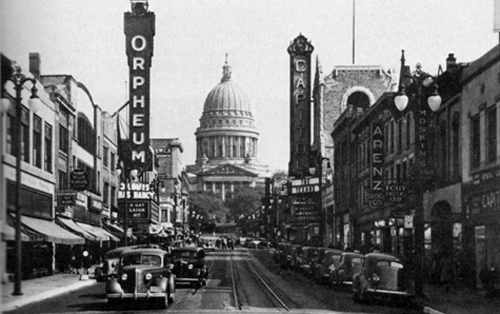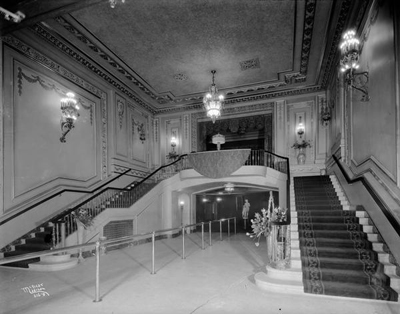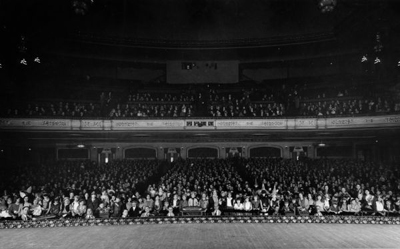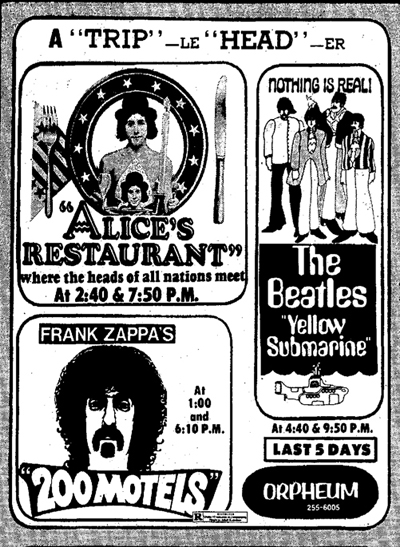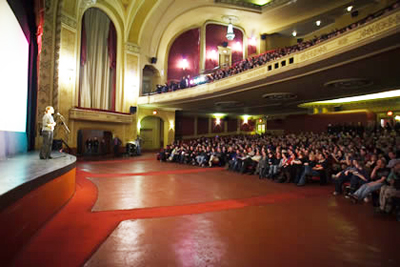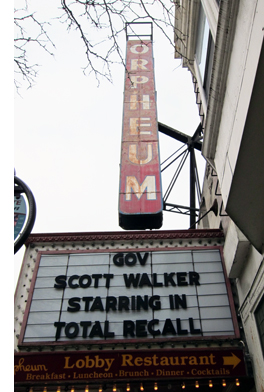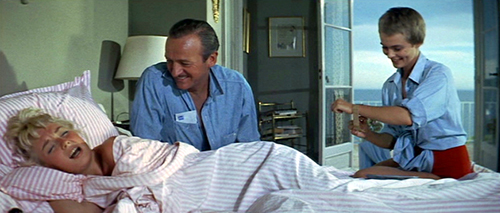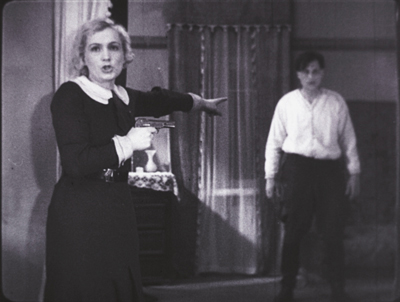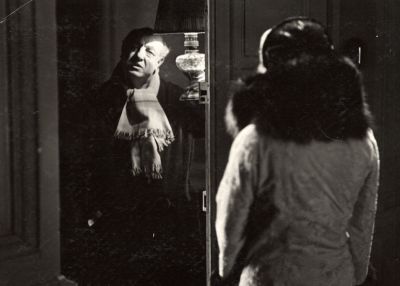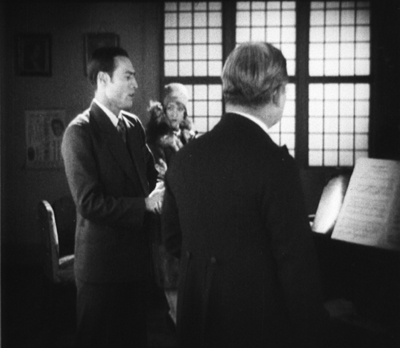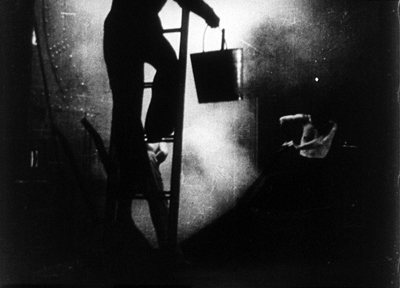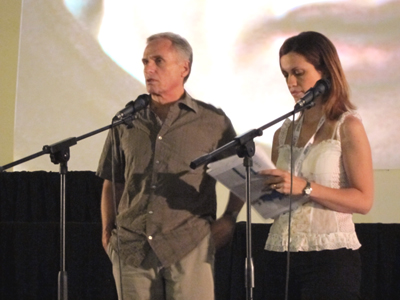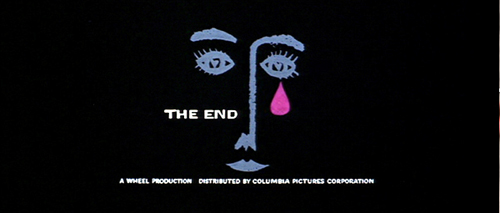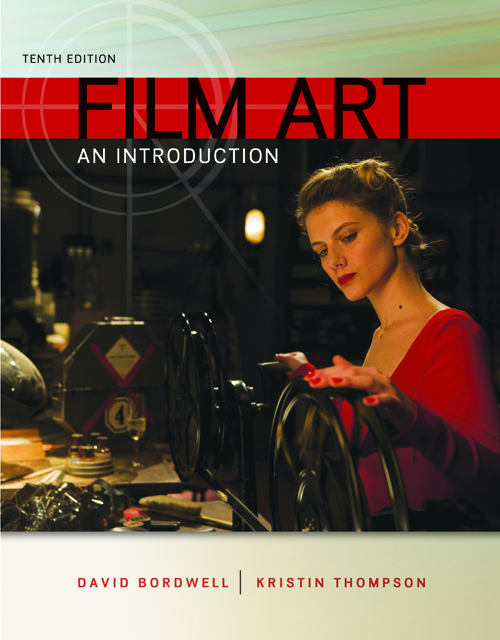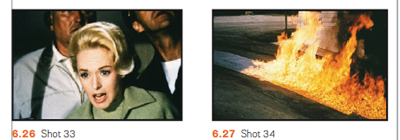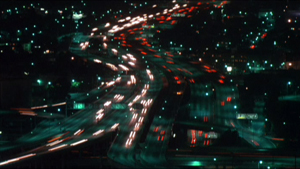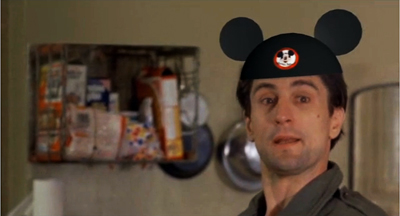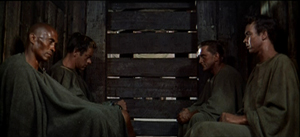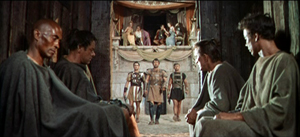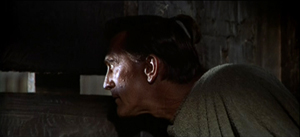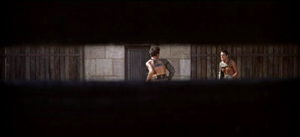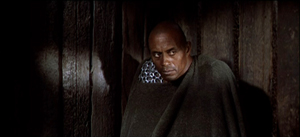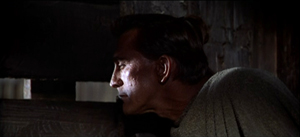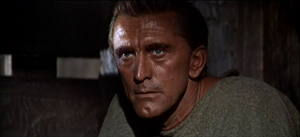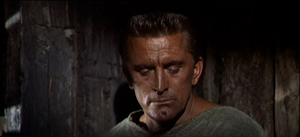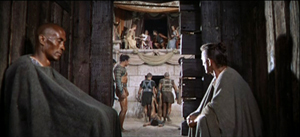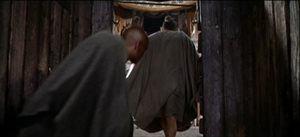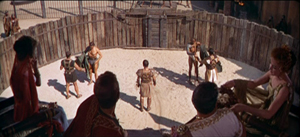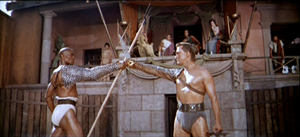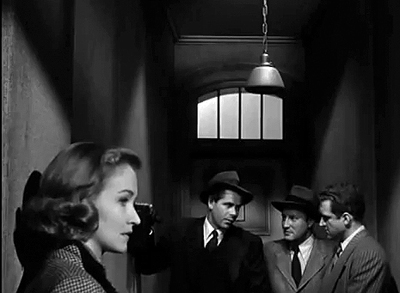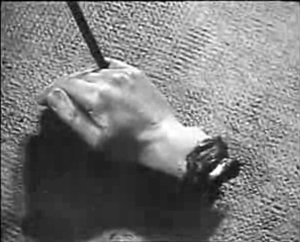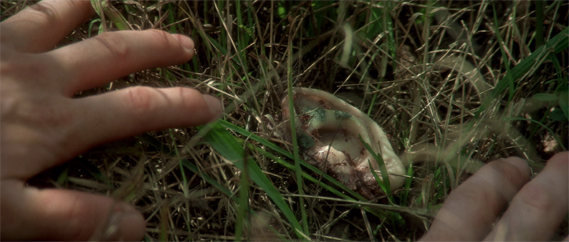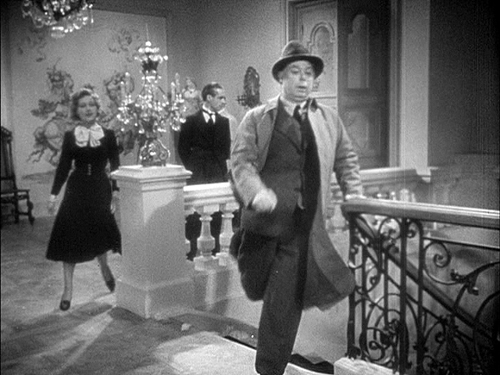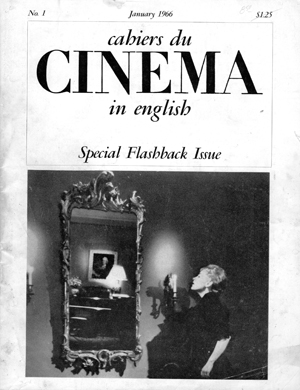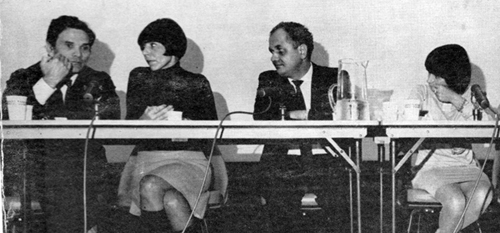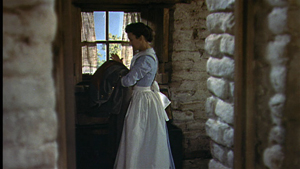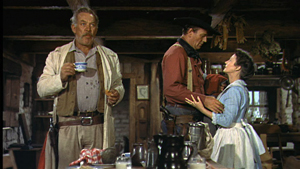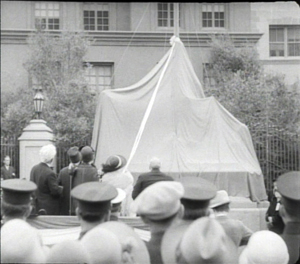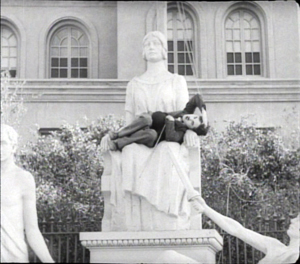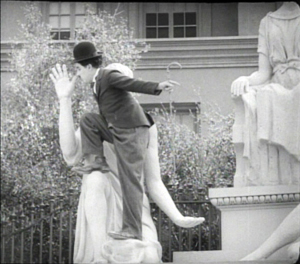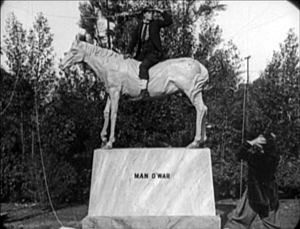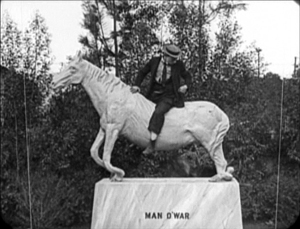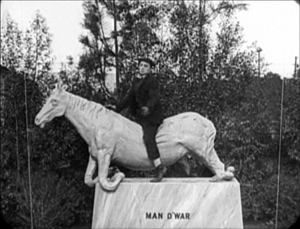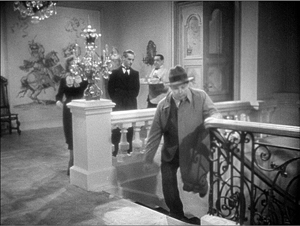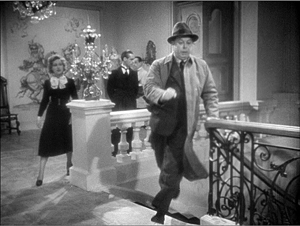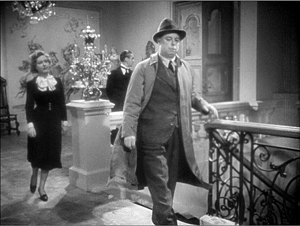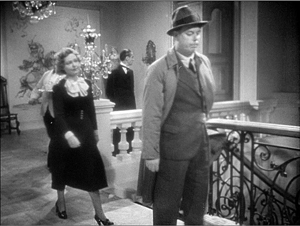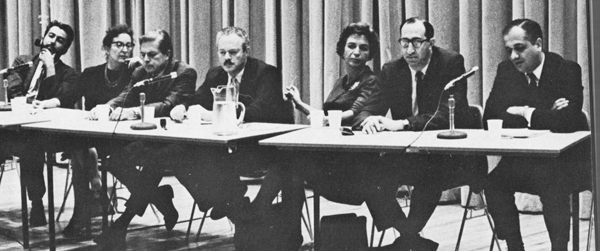Archive for 2012
Orpheum descending
State Street, Madison, Wisconsin, 1927.
DB:
When it comes to film culture, Wisconsin yields to no one in weird-assery. I’ve chronicled Mad City Movie Mania on other occasions (here and here), and a current flap has just added to the annals of the addled.
It revolves around Madison’s Orpheum Theatre, a 1927 movie palace that has gone through many incarnations. In recent years it’s become mainly a music venue, but it was also fitted out with a restaurant and still showed the occasional art movie. Until it was shut down last month.
The problem is that after several years of confusion, feuding, moving money around, petty spite, and general dodginess, nobody knows exactly who owns the Orpheum. Is the owner Henry Doane, local restauranteur, who for years was publicly considered the purchaser? Is it Eric Fleming, Doane partner who became anything but silent? Is it Gus Paras, wealthy landlord and restauranteur, who bid a couple of million for it at auction last month? What of the woman who acquired Fleming’s share of the building? And the shadowy figure who made off with a plastic bag holding $175,000—how does he fit in?
“I’ve never done anything to deserve the negative treatment that I’ve been getting. I’m very compromising. I’m willing to do whatever it takes to make things work—as long as it’s profitable.” Eric Fleming
“I’ve gone through every kind of humiliation known to mankind, so I’m kind of immune to it at this point.” By 2007 the partnership had gone so sour that Doane keyed Fleming’s car in broad daylight.
Please visit the story by Steven Elbow at the Capital Times for all the details. My account will be drawing on Elbow’s patient sleuthing, but I also want to recall the glorious, not to mention the inglorious, days of this old house.
Marbles
Orpheum Theatre, 1927. Photo by Angus B. McVicar. Collection, Wisconsin Historical Society.
Designed by Rapp and Rapp, premiere theatre architects, the New Orpheum opened in 1927. (It was initially called that because it superseded the Orpheum, a vaudeville house in another part of town, which was soon renamed the Garrick and specialized in live theatre.) The New Orpheum’s lavish French Renaissance foyer swept up to a staircase leading to the balcony. The auditorium held over 2400 seats, making it the biggest theatre in town until the slightly larger Capitol was built across the street a year later, also by Rapp and Rapp.
The New Orpheum (hereafter, the Orpheum) was one of those picture palaces that aimed to elevate the filmgoing experience while also being a good community citizen. It had a corps of ushers, a smoking lounge, and a reputation for punctilious service. The theatre sponsored community events too. When the local newspaper launched a marbles tournament, the Orpheum held a screening for 2000 kids.
The kids came early and jammed the State street side of the New Orpheum, so it was necessary to call extra policemen to handle the traffic. Once inside the theatre they yelled and applauded the two comedy features which were shown for them, and practically jumped out of their seats during the showing of “Why Sailors Go Wrong.”
Six months before the 1929 stock market crash, the Orpheum was reportedly selling 20,000-25,000 tickets per week, in a town of about 55,000 souls.
An RKO town
View from the Orpheum stage, Halloween, 1930. Photo by Angus B. McVicar. Collection, Wisconsin Historical Society.
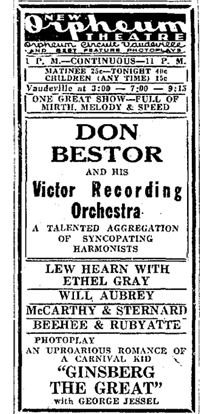 The New Orpheum and the Capitol weren’t in competition, since the Keith-Albee vaudeville circuit owned both. Both houses showed movies, but they seem to have been secondary at the Orpheum. Sometimes Orpheum ads from the late 1920s don’t even mention the titles of what’s playing. (This ad on the right is from 1928.) When talkies came in and the circuit became part of Radio-Keith-Orpheum, films became the central attraction, with live performances as filler. A 1930 kids’ party at the theatre shows the banner flying, “These Madison Boys and Girls Are on their Way to an RKO Theatre.”
The New Orpheum and the Capitol weren’t in competition, since the Keith-Albee vaudeville circuit owned both. Both houses showed movies, but they seem to have been secondary at the Orpheum. Sometimes Orpheum ads from the late 1920s don’t even mention the titles of what’s playing. (This ad on the right is from 1928.) When talkies came in and the circuit became part of Radio-Keith-Orpheum, films became the central attraction, with live performances as filler. A 1930 kids’ party at the theatre shows the banner flying, “These Madison Boys and Girls Are on their Way to an RKO Theatre.”
Despite the Great Depression, RKO moved quickly to monopolize the Madison movie scene. In 1931, the Parkway (capacity 1100) was acquired by the chain, and soon afterward RKO cut a deal with the Fox Film Corporation to take over the Strand (1400 seats). The swap permitted Fox to dominate Milwaukee in exchange for making Madison an RKO town for first-run films. Of course, in good oligopolistic fashion the RKO theatres showed films from all the studios, as did the second-run houses.
I’ve been unable to determine at what point RKO lost control of its Madison screens. [But see the P. S. below.] Presumably it was after the 1948 divorcement decrees severed Hollywood studios from control of theatres. At some point the Milwaukee entrepreneur Dean Fitzgerald acquired seven local houses, including the Orpheum, under the rubric of the Madison Twentieth Century Theater Corporation.
In 1969, a second screen was carved out of the backstage area of the Orpheum and the minuscule theatre that resulted was called the Stage Door. The contrast with the imposing classic house was startling: the Stage Door was almost certainly the worst theatre in town. Then it declined even more. By the end, with its spidery movable chairs and dank atmosphere, it was reminiscent of the storefront theatres of the nickelodeon era, except that they were surely more comfortable.
Less than heavy traffic
Capital Times advertisement, September 1973.
When Kristin and I came to Madison in 1973, we saw a sort of Sargasso Sea of old movie houses. The Majestic, a decrepit vaudeville house built on a plan as cockeyed as an Escher drawing, was showing X-rated fare, kung-fu, and double-bill repertory. It became a Landmark calendar house. A neighborhood house, the Atwood (aka the Eastwood and the Cinema), built in 1930, screened porn and kiddie shows , though not together. The Esquire also offered sex: arty (The Story of O) or not (Dr. Feelgood, with Harry Reems). The mammoth Strand was still functioning as a first-run house; Star Wars played there for months. The Middleton (seating 500 or so) was designed as a Quonset hut in 1946, and was said to have been built in a week. By our day it was playing second run. The Capitol, where I saw The Exorcist, was still operating too. Every year one theatre or another seemed to run the endlessly popular Eastwood Dollars trilogy.
The mall cinemas were emerging as single-screeners or duplexes. They got the premiere first-run pictures like The Sting, often leaving the downtown houses with lesser items. The most obvious options were counterculture movies and sexploitation.
The Orpheum went along. “Entertainment for the Entire Family!” trumpeted a 1965 Orpheum ad, but by 1969 there were revivals of Bullitt and Bonnie and Clyde. Sometimes classier items like The Godfather would show up in second run, but Orpheum fare in the early seventies was more likely to be Heavy Traffic, Enter the Dragon, The Filthiest Show in Town, revivals of headflix (see above), and a double-bill of Russ Meyer’s Vixen and Up! This was the period when the movie page of the papers included ads for This Is Heaven Sauna Massage, The Rising Sun Counseling Clinic (Adults Only), Photographic Arts Do It Yourself Nude Photography (Camera and Film Supplied), Ms. Brews Lounge (Nude Dancing Daily), and The Dangle strip club.
 One by one the theatres were closed or converted to other uses. The Capitol became part of an arts complex. The Orpheum remained the only more or less intact movie house from the old days. By 1998, Dean Fitzgerald was ready to sell it.
One by one the theatres were closed or converted to other uses. The Capitol became part of an arts complex. The Orpheum remained the only more or less intact movie house from the old days. By 1998, Dean Fitzgerald was ready to sell it.
Two forces were contending for the property. As part of a plan to revitalize the downtown area, the Madison Idea Foundation proposed putting in an IMAX facility. But preservationists objected that an IMAX setup would wreck the layout of the house. By contrast, restaurant owner Henry Doane (right) favored restoration. He proposed to rehabilitate the old place respectfully and use it for art films, film festivals, and live music. He also wanted to install an upscale café and bar.
Doane won the City Council’s approval and in 1999 he purchased the Orpheum. Throughout the 2000s, thanks to some clever programmers, it played remarkably eclectic fare, from Arnaud Depleschin ‘s A Christmas Tale to Matthew Barney’s Cremaster cycle (running two weeks, no less). In addition, Doane’s plan to revive the Orpheum as a live music venue, with booze, was finding some success. The grand house that had hosted Gene Krupa, Frank Sinatra, Bob Marley, and Journey now had popular indie bands. When local critic Rob Thomas drew up his list of ten-best shows for the decade, Orpheum concerts took five places. Most memorably, Bela Fleck and the Flecktones played to a packed house the night after the World Trade Tower attacks, highlighted by a version of “God Bless America.”
Drinks plus dining plus music kept the Orpheum doors open, but by the late 2000s the place was obviously not flourishing. There were rumors that distributors, long unpaid, were withholding films. The place was becoming disheveled, with seats broken, that stratospheric ceiling ominously peeling, and the sound system a fog of distortion.
Worse, even though most Madisonians had an affection for the old house, nobody much went there to watch a film. Things had started promisingly: Doane’s introduction to the movie business was the blistering summer of Star Wars: Episode I—The Phantom Menace and The Blair Witch Project. But that was an atypical season. During the 2000s, most of the biggest audiences showed up during the Wisconsin Film Festival. It was indeed thrilling to see the place packed out for classics like A Hard Day’s Night (introduced by Roger Ebert) and imports like The Foul King and Wilbur Wants to Kill Himself (both shown in the presence of the directors).
At some point, accommodations were made to favor the concerts: front rows were ripped out to provide dance space.
It became a wretched place to watch movies. Lobby dance parties during screenings could drown out the soundtrack. District 13 was projected within a rectangle framed by a scaffolding erected for an upcoming show. As the decade wore on, you might go to the Orpheum for music, but you didn’t go for the films.
Orpheum vs. Orpheum
Now we know a bit more about what happened behind the scenes in the 2000s. At some point Doane split ownership of the Orpheum Theatre Co. of Madison 50-50 with Eric Fleming, a real-estate and restaurant operator.
 Fleming (right) is the sort of fellow who gets called “colorful.” He first made it into the Madison press when he opened Crave, a self-consciously hip restaurant noted for its martinis. “People come here to be out and get a little dressed up,” he told one reporter. “Kind of like a ‘Sex and the City’ place.” Maybe a little too much so: A year later Fleming was charged with disorderly conduct for pouring a drink over a Crave customer and groping a female patron. In December 2008, after an altercation that started in the restaurant, one customer was killed on the street by another in the presence of a Crave bouncer.
Fleming (right) is the sort of fellow who gets called “colorful.” He first made it into the Madison press when he opened Crave, a self-consciously hip restaurant noted for its martinis. “People come here to be out and get a little dressed up,” he told one reporter. “Kind of like a ‘Sex and the City’ place.” Maybe a little too much so: A year later Fleming was charged with disorderly conduct for pouring a drink over a Crave customer and groping a female patron. In December 2008, after an altercation that started in the restaurant, one customer was killed on the street by another in the presence of a Crave bouncer.
Fleming’s business style is traced in Elbow’s article. After Fleming became co-owner of the Orpheum, a busted real-estate investment required him to pay creditors $1.5 million. Seeking to dislodge Doane, he created a new company, Orpheum of Madison, claiming that entity as the functioning business arm. He folded that into a package of assets he transferred to Ms. Olesya Kuzmenko for $175,000. “This is what I do for a living,” Fleming explains in Elbow’s article. “I create things and I sell them.”
Who is Kuzmenko, who wound up with a mammoth downtown theatre for the price of a small house on the outskirts of town? She is believed to be Fleming’s girlfriend, but beyond that little is known. She is listed on a license application as President, Vice-President, Secretary, Treasurer, Director, and sole stockholder in Orpheum of Madison. A few years before, Fleming had sold Crave to Christina Bishop, his secretary and girlfriend at the time, under the rubric of a new company Evarc (Crave spelled backward).
There were some curious incidents over these years. There were three fires at the Orpheum, at least two considered by the police to be arson. So far no arrests have been made in the cases. There was also reportedly a break-in, during which a computer was stolen. Perhaps the strangest incident involves the fate of Kuzmenko’s payment. Elbow’s article reports Fleming’s account:
He withdrew the $175,000 he got from Kuzmenko in $100 bills from his bank account, put the cash in a plastic bag and handed it over to a guy identified in court records as Marcus DaMarko, and never saw it again.
“I loaned somebody money,” says Fleming. “I loaned him some money to invest in something. I haven’t talked to him since so I don’t have the money currently.”
So, a reporter asks, you were taken?
“Essentially.”
One more for the road
Because of these maneuvers, Fleming has been running the Orpheum for over a year without input from Doane. The newest issue involves alcohol.
Wisconsin, you must understand, has a frenzied drinking culture. We lead the nation in binge drinking, drinkers per capita, heavy drinkers per capita, and drunk driving. Madison’s main downtown artery, State Street, is packed with bars and restaurants, and the UW’s reputation as a party school attracts an endless supply of youths eager to get wasted. Consequently, what state law calls “alcohol beverages” have been central to the revival of the Orpheum. To establish the lobby restaurant (above) Doane needed to serve beer, wine, and spirits. And Fleming’s cash flow in recent years has been boosted by numerous weddings, which demand booze.
But over the years, the Orpheum’s state vendor’s permit and its liquor license have become problematic. Just during the fall of 2006, the venue under Fleming’s management accumulated some 200 points of alcohol-related violations, and there was a demand that its license be suspended. Across the spring months of 2011, things became more dramatic.
In a series of appeals to the Alcohol License Review Committee of the Common Council, Fleming began to press for the Orpheum’s liquor license to be transferred to his company, Orpheum of Madison. He assured the ALRC that Doane’s original company, Orpheum Theatre Co. of Madison, would be evicted from the premises. Doane replied he knew nothing about this, and indeed he was not evicted. Moreover, he argued that Fleming was making purchases for his own company but billing their original one. And Fleming, he claimed, had changed the door locks. The ALRC, declining to step into the middle of the feud, decided to let Doane’s original company hold the license until ownership was clarified.
Auction fever
That fracas took place a year ago, but things really got going this spring. While Doane was suing Fleming to regain control of the building, the Orpheum faced foreclosure because of unpaid bills. In April it went on the auction block.
 Enter Gus Paras (right), once Fleming friend and now Fleming foe. “He sued me and cost me a lot of money,” Paras explained. “The other thing is I watched people he screwed so bad he put them on their knees.”
Enter Gus Paras (right), once Fleming friend and now Fleming foe. “He sued me and cost me a lot of money,” Paras explained. “The other thing is I watched people he screwed so bad he put them on their knees.”
Gus Paras had had many dealings with Fleming when both sought to buy property in the area. Now Paras wanted the Orpheum as well. But when the property went to auction, along with the 300 block that had also been part of the Fleming/ Kuzmenko package, Olesya Kuzmenko showed up and began bidding against Paras. In a scene reminiscent of the auction in North By Northwest, she bid the price for the Orpheum up to $1.9 million, but Paras won it for $2.25 million. She bid again on the 300 block properties, but Paras bid her up and then folded, leaving her stuck with her $2.25 million bid. But she couldn’t make the down payment, so the court gave both the Orpheum and the 300 block to Paras for $1.9 million each. However, as of this writing, the sale has not yet been consummated. A court will need to determine who actually owns the building.
In the meantime new alcohol problems resurfaced. Doane requested that the Orpheum’s state seller’s permit not be reactivated. It expired. But the Orpheum continued to sell booze. For a time it seemed that every drink poured since April 2011 had been in violation. A June 2012 story explained:
[Assistant City Attorney Jennifer] Zilavy said the Orpheum should not have served alcohol at concerts and other events. She isn’t sure if the city will pursue civil charges, which could result in a $1,000 fine for each infraction, or refer the matter for criminal charges, which could result in a fine of up to $10,000 or nine months in jail per offense.
As a result, last month the Common Council of the city declined to renew the Orpheum’s liquor license. When the police tried to serve notice of non-renewal, they were unable to rouse anyone. “It is locked up, lights out, nobody there,” reported the officer. Now, however, it seems that Fleming managed to re-activate the license fairly soon after Doane deactivated it, so it’s unclear how long, if at all, the Orpheum was serving drinks illegally.
The city later discovered that Fleming, nothing if not tenacious, was at some point granted a state seller’s permit for his new company. But as of early July the sort-of-partners remained at loggerheads. Doane’s company had a liquor license but no seller’s permit. Fleming’s company now has a seller’s permit but no liquor license. And Doane’s company’s liquor license expired last Saturday. The Madison Common Council has sent the matter to the ALRC for a public hearing. possibly as soon as next week.
I wish I could answer every question that’s come up. Who is Mr. DaMarko, and what became of the 1750 $100 bills? If Paras finally acquires the building, what status does Fleming’s operation have with respect to it? What about Doane’s stake in the theatre he originally bought?
One thing seems certain: If the old place resumes operations, it will be as a venue for weddings and live music, with a bar and perhaps a café. As movies evicted vaudeville from the Orpheum in the 1930s, so now live performance has replaced movies. The drama and comedy have moved off the screen into the streets, the Common Council, and the halls of justice.
Steven Elbow follows up his main story here. If anything develops, he will probably report on it in his blog.
The Orpheum website reflects the chaotic state of its circumstances. Videos of the ALRC hearings, from which my three portraits of the protagonists are taken, may be streamed here and here. In late June, Eric Fleming conducted a brief video tour of the Orpheum’s restorations. The most recent application from Kuzmenko’s company requests that the liquor license begin on 1 July 2012 and end on 30 June 2012. Will the fun never stop?
Some accounts date the Orpheum from 1926, but it opened in March 1927. (See, for example, “New Orpheum’s First Birthday Cake,” The Capital Times, 3 April 1928, 3.) To view more magnificent Orpheum photos from the Wisconsin Historical Society collection, go here. The color shot of the Lobby Restaurant is from the Onion. (The Onion originated–where else?–in Madison.) The color shot of the missing front rows is from the 2010 Wisconsin Film Festival. For a sense of what a wedding looks like in the Orpheum, go to Valo Photography.
Wisconsin’s mad flight from sobriety is documented in the Milwaukee Journal-Sentinel‘s award-winning series. As far as I know, nothing much has changed since that 2008 survey.
This has been my Year of Living Exhibitionistically; see the Pandora posts and the e-book for accounts of different movie theatres. Older entries are here and here.
P.S. 15 July 2012: Douglas Gomery writes that RKO probably lost its grip on the Orpheum and other theatres much earlier than I speculated:
The Film Daily Yearbook of 1931 lists RKO holdings in Wisconsin: Madison, the Capitol & Orpheum; Milwaukee, the Riverside; and Racine, the Downtown (literally). In 1932 RKO goes into bankruptcy, and all its Wisconsin holdings disappear from FDY. My guess is that the Orpheum and other houses became locally owned.
Douglas wrote the definitive book on American exhibition, Shared Pleasures, and I thank him for the correction.
P.P.S. 16 July: My original post indicated that Kuzmenko won the Orpheum temporarily before she proved unable to make the down payment. Steve Elbow corrected my claim on this: what she acquired at auction was actually the 300 block property, which had been folded with the Orpheum into the overall property Fleming sold her for $175,000. Gus Paras bid successfully on the Orpheum itself.
The blog has been revised to reflect another piece of information Steve provided me: that Fleming may have reactivated the Orpheum’s liquor license quite soon after Doane deactivated it. Thanks to Steve for these corrections.
P.P.P.S. 27 May 2013: A query from Laura Ursin has led me to correct the date in the caption of the top photo, which I had dated from 1938.
The Orpheum Theatre under construction, 1926. Photo by Angus B. McVicar. Collection, Wisconsin Historical Society.
Solo in Bologna
Kristin here:
Two days before David and I were to set out for Bologna and its annual Il Cinema Ritrovato festival, back pain struck him. He decided not to go, and so our coverage this year will be briefer. I struggled to see as much as possible, but if anything, the program was even more packed than last year.
The auteurs
The main threads included four directors who are of historical interest. Raoul Walsh was the main attraction, with emphasis less on familiar classics like Roaring Twenties and White Heat and more on hard-to-see items like Me and My Gal and other early 1930s films. Lois Weber, the first important female director in American cinema, was represented with as complete a retrospective as possible, including fragments from features not otherwise extant. Jean Grémillon, one of the less famous French prestige directors during the 1930s and 1940s, was extensively represented. And there was Ivan Pyriev (or Pyr’ev, going by the program notes’ spelling), most famous as one of the main proponents of the “kholkoz [collective farm] musicals” of the last 1930s and 1940s.
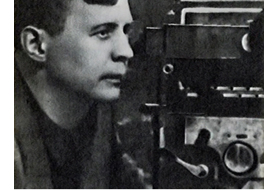 I had seen a couple of Pyriev’s films and decided to see as many as possible of the series on offer, programmed by our long-time front-row neighbor in the Cineteca venues, Olaf Möller. Pyriev is an interesting case historically. He came to filmmaking just as the Soviet Montage movement of the 1920s was coming under official pressure for its formal complexity.
I had seen a couple of Pyriev’s films and decided to see as many as possible of the series on offer, programmed by our long-time front-row neighbor in the Cineteca venues, Olaf Möller. Pyriev is an interesting case historically. He came to filmmaking just as the Soviet Montage movement of the 1920s was coming under official pressure for its formal complexity.
The Civil Servant (or The State Functionary, 1931) was a full-blown, skillful leap into Montage, with an prologue of trains coming into Moscow, shot with canted framings, low angles, and quick cuts with trains moving left, then right. The rest is a satire on bureaucracy within the national railroad system—ostensibly set during the Civil War but clearly a contemporary story. It’s broad in its humor, and it has the obvious typage in the choice of actors, the wide-angle lenses that the Montage filmmakers explored in the late 1920s, and other scenes of quick cutting with jarring reversals of directions.
Official dislike of The Civil Servant kept Pyriev from directing again for three years. Turning his back on Montage, he went to the other extreme, helping to develop the kholkoz (collective-farm) musical and making some of its liveliest, most entertaining, and most enthusiastic examples of that genre. His Traktoristi of 1939 was not shown during the festival, but one that I hadn’t seen, Swineherd and Shepherd (1941), is fully its equal. From the moment the film begins, with the camera madly tracking backward through a birch forest as the heroine runs full tilt after it, singing joyously to the masses of pigs that emerge from corrals and gallop along with her, the spectator realizes that this film will be exactly what one wants and expects from Pyriev.
A later entry in the genre, The Cossacks of the Kuban (1950), was even better, and I can see why it is Olaf’s favorite. The opening vistas of immense wheat fields, gradually moving to scenes with tiny figures and finally to ranks of harvesting machines and trucks achieves a genuine grandeur, aided considerably by the fact that by this point Pyriev is working in color. The story goes beyond the simple stock figures of some of the earlier musicals, with a stubborn Cossack who heads one collective farm nearly missing his chance at romance with a widow who heads a rival farm.
Overall, I like these films a little better than those of his more famous colleague in the creation of buoyant musicals, Grigori Alexandrov. Yet it has to be mentioned that there is a certain underlying unease in being entertained by films that created hugely idealized images of life on collective farms. In reality many peasants were starving, and few were working with such cheerful enthusiasm to increase production for the sake of the great Soviet state. One might rationalize this dissonance by thinking that Pyriev was perhaps making fun of his subject with over-the-top dialogue and musical numbers. Yet surely to many audiences at the time, this was escapist entertainment, and urban audiences may have had little sense of the blatant inaccuracy of the portrayals of the countryside.
Two more straightforward dramas, The Party Card (1936, below) and The District Secretary (1942), a war story, were more conventional Socialist Realist works, skillfully done but lacking the appeal of Pyriev’s lighter films.
It was sad to see the one post-Stalinist film from Pyriev’s late career, his adaptation of The Idiot (1958). A sumptuous production, again in color, it consisted almost entirely of overblown confrontations among characters. The actors shout all their lines at each other with almost no variation in the dramatic tone, with everything underlined by an amazingly intrusive musical score.
I saw only a few of the Walsh films, since they frequently conflicted with the Pyrievs and Grémillons and just about everything else on offer. To me, the director was a bit oversold. Peter von Bagh’s introduction to the catalog says, “Unjustly, Raoul Walsh, although blessed with so much cinephilic worship, is usually placed a few notches below his more revered colleagues Ford and Hawks. Now he will have a chance to be upgraded, in our continuing series featuring extensive screenings from Walsh’s silent period through his very rare early sound films.” Perhaps Walsh will go up a notch in people’s estimations—the screenings of his films were certainly very popular—but not, I think, the few notches it would take to place him alongside these two other masters. I enjoyed Me and My Gal, a rare 1932 comedy in which Spencer Tracy and a very young Joan Bennett adeptly exchange snappy patter, yet it occurred to me more than once during the screening that Twentieth Century (1934) is a much funnier film.
The Big Trail, shone in its original wide-screen Grandeur format on the giant Arlecchino screen, was better than I expected. Walsh was given enormous resources to tell the story of a large wagon train making its way to Oregon from the Mississippi. He showed off the crowds of wagons, cattle, and people by the simple expedient of raising the camera height so that most of the screen’s height became a tapestry of people stretching into the distance, all going about their business while the main dramatic action in the foreground occurred. This often involved a very young John Wayne, whose occasional awkward delivery of lines managed somehow to fit with his character.
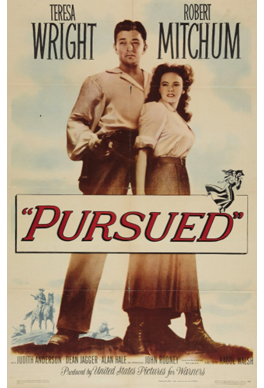 Pursued (1947), shown in an excellent 35mm print, was one of the few certified Walsh masterpieces in the series. Of course I enjoyed it. It struck me how crucial the casting of Teresa Wright as heroine Thor Callum was. So often Westerns have minor actresses as the love interest, women that one can seldom recall seeing in any other film—starlets rather than stars. Thor’s dramatic arc is pretty extreme and somewhat implausible, but Wright manages to make the character convincing and sympathetic, as well as an effective counterpoint to Robert Mitchum’s stolid Jeb Rand. James Wong Howe’s cinematography was also a big plus.
Pursued (1947), shown in an excellent 35mm print, was one of the few certified Walsh masterpieces in the series. Of course I enjoyed it. It struck me how crucial the casting of Teresa Wright as heroine Thor Callum was. So often Westerns have minor actresses as the love interest, women that one can seldom recall seeing in any other film—starlets rather than stars. Thor’s dramatic arc is pretty extreme and somewhat implausible, but Wright manages to make the character convincing and sympathetic, as well as an effective counterpoint to Robert Mitchum’s stolid Jeb Rand. James Wong Howe’s cinematography was also a big plus.
Few of Walsh’s pre-1920s films survive, but those few were shown. I skipped the wonderful Regeneration, having seen it multiple times, but I caught The Mystery of the Hindu Image, notable mainly for Walsh’s own performance as the detective, and Pillars of Society, a somewhat stodgy adaptation of the Ibsen play.
I can’t say much about the Weber films, since they were consistently in conflict with screenings of films by the other main auteurs. I regret having skipped one Pyriev film, Six O’clock in the Evening after the War (1944) to see Shoes (1916), which had been touted as one of the director’s best. It proved a considerable disappointment, stuffed with expository intertitles that often simply described what we could already see from the action in the images. This may have been because Weber’s “discovery,” Mary McLaren, was so inexpressive. She almost constantly wore the same expression of resigned sadness at her family’s grinding poverty, varying it occasionally with a look of annoyance at her father’s shiftless behavior. I tried to steer people to The Blot, which is probably Weber’s masterpiece among the surviving films.
It was fairly easy to see most of the Grémillon titles, because a number of them were repeated in the course of the week. I enjoyed Maldone, which I had seen once long ago. Its story involves a runaway heir to a large estate who has run away as a young man and now, in late middle age, works on a canal barge. Infatuated with a beautiful gypsy and spurned by her, he returns to claim his inheritance, only to be disgusted by gentrified life. Like Pyriev, Grémillon came late to one of the commercial avant-garde movements of the 1920s, French Impressionism. He uses the subjective camera effects and the rhythmic editing in a straightforward way, with little of the flashiness of a L’Herbier or a Gance. Maldone and his subsequent film, Gardiens des phare (1929), shown at the festival in a tinted Japanese print, remind me of perhaps the best filmmaker of the Impressionist movement, Jean Epstein.
This legacy might logically have led Grémillon into the Poetic Realism of France in the 1930s. Unfortunately his first sound film, La petite Lise (1930), which might be said to fit into that tradition, was not shown. After seeing several of the films on offer this year, I still think it may be his masterpiece. (We talk about it briefly in the section on early sound cinema in Film History: An Introduction.) Though some might argue that he has at least one foot in that tradition, his work is perhaps closer to what the Cahiers du cinéma critics later dubbed the Cinema of Quality.
As for the others I caught: L’étrange Monsieur Victor (1938, dominated by Raimu as a successful merchant who is not all he seems), Remorques(1939-41, perhaps Grémillon’s best-known film, re-teaming the favorite French couple of the 1930s, Jean Gabin and Michele Morgan), and Pattes blanches (literally, “White putties,” 1948). I enjoyed them all, and yet there was no sense of discovering an overlooked genius. Best of the sound features for me was Pattes blanches, which tempered Grémillon’s taste for melodrama with a hint of surrealism. The obsessive young wastrel Maurice (played by a very young Michel Bouquet), the gamine hunchback maid who falls in love with the reclusive and menacing local nobleman, and the nobleman himself, invariably bizarrely clad in his white puttees, help give the film a fascination that the others, for me at least, lack.
The themes
There were other threads oriented by genre or topic or period. These I sampled when it was possible to insert them into my schedule. One of these was “After the Crash: Cinema and the 1929 Crisis,” which included an intriguing potpourri of documentaries and fiction films from several countries and political stances, from Borzage’s A Man’s Castle to two short films by Communist-leaning Slatan Dudow, director of Kuhle Wampe. Because of my interest in international cinema styles of the late 1920s and early 1930s, I went to Pál Fejös’s Sonnenstrahl (“Sun Rays,” 1933) was shown in the festival’s first time slot, 2:30 on Saturday afternoon. It thus competed with the first showing of the Grandeur version of The Big Trail and the first program of the “Cento anni fa” set of 96 films from 1912, but such is Bologna’s lavish scheduling.
Fejös, a Hungarian, made films in Hollywood, France, Denmark, Sweden, and a number of other countries. Sonnenstrahl, with its romance between German actor Gustav Fröhlich and French leading lady Annabella, is basically a reworking of the director’s best-known film, Lonesome (1928), with touches of 7th Heaven (Borzage, 1927), redone for the Depression era. It’s a pleasant enough piece, though not up to Fejös’s best work of the 1920s. Again, the program claims to too much for the filmmaker by saying that some historians consider him “as one of the cinema’s great poets, along with Murnau and Borzage.”
The Depression program also included a surprisingly good early sound film by Julien Duvivier, David Golder (1931, above). It’s the story of a wealthy businessman, played by Harry Baur, who discovers that his wife and daughter love him only for his money. How he could have lived this long with them without realizing this is perhaps a weakness in the plot, but from the start Duvivier showed a remarkable assurance in framing, cutting, and camera movement that was continually in evidence. Sets by the great Lazare Meerson also enhanced the style.
Baur also starred as Jean Valjean in Raymond Bernard’s 1934 three-part Les Misérables. I skipped the screenings, since the film is available in a Criterion boxed set (along with Bernard’s remarkable 1932 anti-war film Wooden Crosses). The Bernard film was part of the “Ritrovati and Restaurati” thread. The presence of Baur in both David Golder and Les Misérables led to the Depression and Ritorvati threads to weave together to produce a third: “Homage to Harry Baur.”
The only other entry in this brief thematic collection was Duvivier’s La tête d’un homme (1933), the third film based on a novel by Georges Simenon. Baur stars as Commissioner Maigret, and Valery Inkijinoff (known largely as the hero of Pudovkin’s Storm over Asia/The Heir of Ghengis Khan, though he acted in numerous other films as well) plays the doomed, obsessive villain, Radek. The film is not as accomplished as David Golder, but it’s an entertaining little thriller with some novel twists. Early in the film the murder is revealed, and we know from the start the Radek committed it. The duel between him and Maigret becomes the focus of the action. Moreover, the very first scene introduces a thoroughly unlikeable fellow who initially seems to be the villain, a womanizing cad who lives by gambling and other unsavory activities, yet who himself eventually comes to be tormented and threatened by Radek.
Another intriguing thread was “Japan Speaks Out! The First Talkies from the Land of the Rising Sun.” Ordinarily I would have tried to see most of these, but again they conflicted with the auteur threads I was trying to follow. I did make it a point to see Mizoguchi’s first sound film, Hometown (1930, above), since it’s one of the hardest to see. A part talkie built around a famous Japanese tenor and opera singer, it was more an historical curiosity than a satisfying film. I reluctantly skipped Heinosuke Gosho’s delightful Madame and Wife (aka The Neighbor’s Wife and Mine), the first really successful Japanese talkie, having seen it a number of times. On David’s and Tony Raynes’ advice, I caught Yasujiro Shimazu’s First Steps Ashore, a romantic tale inspired by Von Sternberg’s The Docks of New York. It didn’t quite match the original (as what could?) but was an entertaining tale well acted by the two leads. The first frame below reflects something of the style of Docks of New York, but the second, more typical of the film, is pure Shochiku.
The organizers of Il Cinema Ritrovato have declared that they will continue to show films on 35mm as long as possible. Most of the screenings that I attended were indeed on film. There’s no doubt that the move to digital restoration became dramatically more apparent this year. Nearly all of the 10 pm screenings on the Piazza Maggiore were digital copies, including Lawrence of Arabia, Lola, La grande illusion, and Prix de beauté. David and I don’t usually go to these screenings, since we invariably want to see films in the 9 or 9:30 AM time slots and don’t want to fall asleep during them. But I did catch two digital restorations shown earlier in the evening in the Arlecchino.
The first, Voyage to Italy, was flawless and sharp—perhaps a little too sharp. I liked the film much better than the first time I saw it, maybe because I understood better the claims that are made for it as a forerunner of the art cinema of the 1960s, with the aimless, confused couple presaging the characters of directors like Antonioni.
Perhaps the high point of my week, though, was an entry in an ongoing thread at the festival, “Searching for Colour in Films.” There were many films in this category, which was broken down into the silent and sound eras. Bonjour Tristesse may well be my favorite Otto Preminger film. Our old friend Grover Crisp (above, with interpreter) returned to Bologna to introduce it in a digital restoration, but one which, he assured us, retained the grain of the original film. It was certainly a beautiful copy and looked great on the Arlecchino screen. (The frames at the top and bottom of this entry were taken from a 35mm copy, not a DVD or the new restoration.)
Il Cinema Ritrovato grows more popular each year. A number of our friends from other festivals and alumni of the University of Wisconsin-Madison’s film studies program attended for the first time and vowed to return. Perhaps a sign that the event is gaining real prominence internationally was the fact that Indiewire columnist Meredith Brody also made her first visit. She conveys the impressions of a newbie in a series of posts: Day 1, Day 2, Day 3, Day 4, and Day 5. For many images of the festival guests and screenings, see the official website.
David analyzes one Hitchcock-like scene in The Party Card in his On the History of Film Style.
July 9: Thanks to Ivo Blom for correcting my spelling of Harry Baur’s name.
You the filmmaker: Control, choice, and constraint
DB here:
The tenth edition of our textbook, Film Art: An Introduction will be available in early July. It has so many new features that it’s our most extensive revision in at least a decade.
Kristin has already written about one of our major additions: supplemental film extracts from the Criterion Collection, with voice-over commentary and other sorts of analysis. (Go here for a sample.) These will be accessible to professors for incorporation into their syllabi. More of them may also become generally available on the Criterion website.
The text has been extensively rewritten, aiming at maximal clarity and freshness. There are many local changes too, with updated examples from a variety of films both old and new. Regular readers will notice that we have made two replacements: Koyaanisqatsi is now our example of associational form, and Švankmajer’s Dimensions of Dialogue is our example of experimental animation. Regretfully, we had to drop our earlier examples, Bruce Conner’s A Movie and Robert Breer’s Fuji, because they are available only in 16mm, and most teachers and readers don’t have access to them. On the other hand, we enjoyed analyzing the new items and think that they serve their purpose very well.
Today I’m going to point out some of the broader changes, while also considering the book’s overall approach.
Parts and wholes
When Film Art appeared in 1979, it was the first textbook in English written by people who had received Ph.D.s in film studies. Specifically, FA emerged from my teaching a lecture-and-discussion course called “Introduction to Film” to several hundred students each semester for many years.
In the mid-seventies, there were almost no film studies textbooks, and none of them seemed to us to reflect the directions of current research. As a result, the first edition of FA included topics that were emerging in the field, such as narrative theory and conceptions of ideology. It also suggested a coherent, comprehensive view of cinematic art, from avant-garde and documentary cinema to mainstream film and “art cinema.”
The book has changed since then, but its approach has remained consistent in two primary respects. For one thing, it tries to survey the basic techniques of the medium in a systematic fashion. Here the key word is “systematic.” It seemed to us that we might go beyond simple mentioning this or that technique—editing, or acting, or sound—and instead treat each technique in a more logical and thorough way. But film aesthetics wasn’t yet conceived in this way, so to a considerable extent the textbook had to offer some original ideas.
For example, most people thought of editing primarily as a means of advancing the film’s story. That’s certainly accurate up to a point, but we tried to go up a level of abstraction. We suggested that the change from shot to shot had implications for what was represented (the space shown in the shots, the time of the action presented), as well as for the sheer graphic and rhythmic qualities onscreen, independent of what was shown. That created four dimensions that the filmmaker could control, and we illustrated how Hitchcock shaped all of them in a sequence from The Birds.
Nobody before had surveyed editing’s possibilities in this multidimensional way. The result was that we were able to trace out several expressive options. We analyzed the 180-degree system for presenting story space, and Film Art became the first film appreciation textbook to explain this. We also laid out ways in which shots could manipulate the order, duration, and frequency of story action. We also considered sheerly graphic and rhythmic possibilities of editing, not all of which are tied to narrative purposes. Similarly, we tried to show that sound, another familiar technique, could be understood as a bundle of systematic options relating to sound quality, locations in space, relation to time, and other factors.
In sum, very often the array technical options had an inner logic. This urge to cover all bases helped us notice options that usually escaped critics. So by concentrating on the graphic dimension of editing, we noticed that some filmmakers tried to create pictorial carryovers from shot to shot, a device we called the “graphic match.”
A second core principle of the book was the idea that we ought to think about films as wholes. There’s a strong tendency in film criticism, in both print and the net, to fasten on memorable single sequences for study. There’s nothing wrong with this, of course, but we think it needs to be balanced by considering how all the sequences in a film fit together. That led us to consider various types of large-scale form, both narrative and non-narrative.
Again, this was new to the field. We showed students how to divide films into parts and then trace patterns of progression and coherence across them. This is a valuable skill for both intelligent viewers and people who might want to work in filmmaking. We showed how the distinction between story and plot could help explain large-scale narrative construction. We suggested that issues of point-of-view and range of character knowledge exemplified broader principles of narration, the ways films pass information along on a moment-by-moment basis. And although most film courses show narrative films (mine did too), we wanted students to think about other large-scale organizational principles too, such as rhetorical argument and associational form. Again, thinking about these more general possibilities led us to consider creative options that hadn’t been the province of introductory texts, such as rhetorical documentary and poetic experimental cinema.
These two efforts—comprehensive study of techniques and a holistic emphasis on total form—weren’t FA’s only salient points. We tried to incorporate more familiar elements from genre studies and historical research. But they did set the book apart, and do still. I believe that we made contributions to our understanding of film aesthetics. One measure of these contributions is the extent to which FA has been regarded as not only a textbook but an original contribution to film aesthetics. Another sign is the fact that other textbooks have relied, sometimes to a startling degree, upon FA for concepts, organization, and examples.
Categories, categories
Associational form: Koyaanisqatsi.
Still, we did encounter objections.
Some readers worried that FA’s layout of logical categories took away some of the magic and mystery: Art dies under dissection. Some also protested that filmmakers didn’t use the categories and terms we invoked. These concerns have, I think, waned a bit over the years, but I’ll address them anyhow.
First, as to the need for categories. As a genre, the textbook in art theory has a very old ancestry. Aristotle’s Poetics, a survey of what we’d now call literary art, bristles with categories—drama vs. epic, comedy vs. tragedy, types of plots, etc. In the visual and musical arts, from the Middle Ages into the Renaissance, writers tried to systematically understand the principles of artists’ practice. Leon Battista Alberti’s treatise on painting tried to show that as an activity, painting had many “parts,” such as drawing, color, and light.
This classificatory urge continued through the centuries, and it continues today. Pick up a book on the visual arts today and you’ll see chapters on composition, color, texture, and the like. The same goes for music; an introductory book will survey rhythm, harmony, melody, musical forms, and so on. There’s no escaping some sort of categorizing if we want to understand any subject, and this goes as well for art traditions.
The categories governing centuries-old arts are largely taken for granted. But film is a newish medium, and film studies a still-young academic discipline, so there remains a lot of exploratory thinking to be done. In the late 1970s, Film Art undertook some of that exploration.
A lot of thinking about film employs categories that are very abstract and general (say, “realism” versus “non-realism”). Our frame of reference tries to be more concrete, more fitted to the particularity of what films actually look and sound like. Whenever we could, we incorporated filmmakers’ explicit concepts into our analyses. FA, for instance, was the first appreciation textbook to introduce the principles of continuity editing that were craft routines among directors and cinematographers.
At other times, we tried to synthesize ideas that were circulating in the filmmaking community. For example, for several decades filmmakers and critics have been saying that editing is getting faster, close-ups are getting more prominent, and camera movements are becoming more salient, even aggressive. From studying hundreds of films, we came to the conclusion that these trends are part of a new approach to film style, and we dubbed that “intensified continuity.” That term aims to capture the idea that for the most part these techniques are in accord with traditional continuity editing, but they sharpen and heighten its effect.
Occasionally we tried to clarify concepts. Most notoriously, we borrowed from French film theory the distinction between “diegetic” and “nondiegetic” sound because all the other terms (“source music,” “narrative music,” etc.) seemed to us ambiguous or inexact. As with most categories, individual films can play with or override this distinction, but it’s a plausible point of departure because traditionally the distinction is respected.
Contrary to some objections, then, we often worked with ideas used by practicing filmmakers. Where traditional terminology seemed inadequate to those ideas, we created our own. And some effects we may notice in movies may have no currently accepted names. In some cases, as in the graphic match, the phenomenon may not even have been identified. We haven’t tried to conjure up fancy labels; we’ve just tried to point to the ways some films work. Anyhow, the term doesn’t matter much, but the concept does.
So one way to think about the categories of form and style in FA is to see them as bringing out principles underlying filmmakers’ practical decisions. A director may choose to do something on the basis of intuition, but we can backtrack and reconstruct the choice situation she faced. If we want to survey the possibilities of the medium, one way to do it is to build categories that show the expressive options available, even if filmmakers don’t sit down and brood on each one.
Thinking like a filmmaker
Walt Disney’s Taxi Driver (Bryan Boyce).
Categories are inevitable, and they allow us to consider creative choices systematically. Making this second point explicit is the most important overall revision in the new version of Film Art.
Previous editions took the perspective of the film viewer. This is reasonable: Teachers want to enhance their students’ skills in noticing and appreciating things in the movies. But from the start FA also indicated that the things we discussed also mattered to filmmakers. As the years went by, we incorporated more comments and ideas from screenwriters, cinematographers, sound designers, directors, and other artisans—often as marginal quotes that, we hoped, would reinforce or counter something in the main text.
Now, though, we’ve shifted the perspective more strongly toward the filmmaker—or rather, toward getting the viewer to think like a filmmaker.
Until recently, most of our readers hadn’t tried their hand at making movies. But with the rise of digital media, a great many young people have begun making their own films. Some of these are variants of home movies, records of concerts or parties or a night out. But many of these DIY films are more thoroughly worked over. They’re planned, shot, and cut with considerable care. Posted on YouTube or Vimeo, they exist as creative efforts in cinema no less than the films that get released to theatres or TV. If you doubt it, look at lipdubs, or meticulous mashups like Bryan Boyce’s.
So, we thought, many students are now able to consider film art as practicing filmmakers. For one thing, that means they’re more aware of the techniques we explain. (Probably nothing in Film Art is as tough as mastering Final Cut Pro.) Moreover, the very act of making films has made students sensitive to alternative ways of doing anything. Accordingly, this edition emphasizes that the resources of the film medium that we survey constitute potential creative choices which yield different effects.
Take an example. We can explain the idea of restricted versus unrestricted narration abstractly. Restricted narration ties you to a limited range of knowledge about the story action; unrestricted narration expands that range, often presenting action that no single character could know about. Filmmakers intuitively make choices along this spectrum even if they don’t use the terminology. Then again, sometimes they do. A while back we quoted the director of Cloverfield:
The point of view was so restricted, it felt really fresh. It was one of the things that attracted me [to this project]. You are with this group of people and then this event happens and they do their best to understand it and survive it, and that’s all they know.
In Stanley Kubrick’s Spartacus, the hero and three other captives are chosen to fight in the arena. They sit sealed in the holding pen while we hear Crassus and his elite colleagues chatting pleasantly about their trivial affairs.
When the combat starts, we’re still confined to the shed. Crixus and Galeno are summoned out, and the door slides shut, leaving Spartacus and Draba alone.
The director has already made several important choices, notably contrasting the carefree chatter of the rulers with the grim prospects of the gladiators (the latter underscored by relentless music). But now there’s a big fork in the road: To show the first combat, or not?
Kubrick chooses not to. We hear the call, “Those who are about to die salute you!” We hear swords clashing, and Spartacus peers outside through the slats. We see only what he sees.
Draba studies Spartacus, who closes his eyes to shut out the spectacle outside.
The two men share a look, but Spartacus turns his gaze away, as if unwilling to confront the cost of killing this man who has done him no harm.
This stretch of the scene is too detailed and varied for me to replay in full, but it’s all confined to the two men in the shed—their reactions to what they hear and what Spartacus sees, and the development of a mix of wary appraisal and desperation. No words are spoken.
The fight outside concludes, and at the climactic moment Kubrick cuts to a new angle that puts Draba and Spartacus in the same frame, realizing that their time has come. The door slides open again, and the men step out.
The exchange of glances has been just ambiguous enough to make us wonder whether the two will really try to kill one another. Restricting us to the holding pen gives us a moment to watch them pondering their fates and enhances the suspense about the outcome of their fight.
Every instant presents the director with a choice that can shape the viewer’s experience. When the men go out, Kubrick must decide on what to show us next. Most daringly, he could keep us in the shed and let us glimpse the fight from there. But that would be a very unusual option in American commercial cinema. Instead, the next shots expand our range of knowledge by shifting us to a different character’s reaction. Before showing us the arena, we get a shot of Virinia, the slave just bought by Crassus. As a result, she is marked as important before we get a general shot of the arena.
Eventally, a master shot ties together all the characters before we move to the next phase of the scene.
As Darba and Spartacus start their fight, you can argue that the effect of it is even stronger because we haven’t seen the earlier match. Restricted presentation of the first combat, seen only through Spartacus’s eyes, throws the emphasis on this one.
By shifting our attention to filmmakers’ areas of choice, we haven’t really abandoned thinking from the standpoint of the spectator. The two views complement each other. In effect, we’re reverse-engineering: thinking like a filmmaker sharpens our sense of how the spectator’s experience can be shaped. From either perspective, we need concepts, categories, and terminology.
To futz or not to futz?
Undercover Man (1949).
Once we notice the concrete results of creative choices by director, cinematographer, editor, and others, we’re inclined to compare how filmmakers have pursued different options, and how these decisions yield different effects. So you might contrast Kubrick’s treatment of the combat with the free-for-all in Ridley Scott’s Gladiator. There the period of waiting is short, and all the emphasis is put on the bloody combat.
Film Art uses the comparative method often, again to illustrate the range of choice available to the filmmaker. Let’s take some instances that have implications for both narration and sound. Telephone conversations are a staple of filmic storytelling. In such a scene, you as a director face a decision tree. Whatever you choose leads to other choices.
Should you show both characters in the conversation, or only one? A passage from The Big Clock presents both options, one after the other.
This illustration suggests that if the character on the other line plays a significant role in the story, you may want to show him or her. Max isn’t as important as Stroud’s wife and son. Once you’ve decided to cut back and forth, you’ll still have to decide when to cut—at what points to show us characters’ reactions. You might want to replay this clip to see how the cutting pattern highlights certain responses.
Alternatively, you can stick with one character and conceal the other party, even if that character is important. Here’s an example from Joseph H. Lewis’s Undercover Man.
Unlike Max in the Big Clock scene, this caller is an important character, a prospective snitch. By not showing him on the other end of the line, Lewis concentrates our attention on the federal agents and builds a little suspense. He goes even further: By not cutting in to Warren as he talks, the direction emphasizes the reactions of Judy, Warren’s wife. Her response is highlighted when she turns slightly into profile, registering her realization that her husband has to leave her on a dangerous mission sooner than she expected.
Sticking with one character triggers another choice about telephone talk: Do you let us hear the other party or not? So far, all our examples have suppressed the voice of the person on the other end of the line. But of course you could let the viewer hear that.
There’s a new problem coming up, though. You need to make it clear that the voice is coming through the receiver, not from someone outside the frame. So a convention has arisen: Words coming through the phone line are distorted, in a process called “futzing.” Here’s an example of subdued futzing from I Walk Alone.
And here’s a case from The Blue Dahlia illustrating the difference between the two sorts of sound even more sharply. Here it’s especially important to let the audience know that what’s being heard is a recording.
This isn’t to say that every choice is absolutely fixed. You can experiment. This is what King Vidor did in H. M. Pulham, Esq. Pulham gets a call, and though we stay with him, the voice isn’t futzed; the effect is a bit unnerving.
Vidor explains:
We were breaking with tradition. When the sound men took over, it became the cliché to put all telephone voices through some sort of filtering device. This made it sound distorted and weird. It occurred to me, why should the audience strain to listen? The person with the receiver up there on the screen doesn’t strain to hear the voice. There isn’t any kind of mechanical distortion. I thought we should just direct it to sound the way it sounded to the person.
The film’s plot concerns Pulham’s regrets about the missed opportunities of his youth. When he gets calls from old friends, their voices seem unusually immediate, more vital and “present” for him than the people in the life he’s leading now.
These creative options show how even small stylistic decisions affect narration and the viewer’s response. Presenting both characters on the phone creates more unrestricted narration, and this allows us to gauge reactions to the action. By showing only one character, you concentrate on that person and the people around them.
If you suppress the words spoken on the other end of the line, you maintain some uncertainty about what’s happening, and you don’t share with us what the listener knows. In contrast, if you let us hear what the listener hears, you tie us to their range of knowledge and perhaps create a bond with them. And as Vidor suggests, you can try to create a deeper subjectivity by letting us hear the speaker as the listener does.
Although Vidor’s experiment wasn’t taken up, directors have continued to try different ways of rendering phone conversations. It would be fun to compare Larry Cohen’s two “phone” scripts, Cellular and Phone Booth, in these terms—not least because of the eerie sound design applied to the mysterious caller harassing the hero of Phone Booth.
Choice and change in history
Un Chien andalou (1928); Blue Velvet (1986).
In such ways, the categories we survey can be thought of as a range of possible options facing filmmakers. But all of them aren’t available to every filmmaker. As every filmmaker knows, you choose within constraints, and some of those constraints are the result of history.
As in earlier editions, Film Art concludes with a chapter surveying artistic trends across film history. But now we’ve tried to integrate the idea of thinking like a filmmaker into that section, emphasizing the interplay of choice and constraint. Most obviously, budgets limit choices. Other constraints might be technological; not all filmmakers have been able to film in color, or to use advanced special effects. Some constraints involve matters of fashion: some acting styles and staging methods aren’t widely acceptable today. In our final chapter we show how certain traditions and schools of filmmaking confronted the constraints of their period and place. Sometimes filmmakers worked within those constraints, and sometimes they overcame them by trying something different.
At the same time, we break with our previous editions by weaving recent films into the history chapter. We try to show that the expressive choices made by filmmakers long ago have returned in our time. The earliest short films, based on novelty and surprise events, have successors in YouTube videos. Contemporary filmmakers draw on techniques favored by German Expressionism and French Impressionism. (Recent examples on the blog are here and here.) Current Iranian films owe a good deal to Italian Neorealism, while the Dogme filmmakers tried to revive some of the insolent force of the French New Wave. It isn’t just a matter of influence, either. Contemporary filmmakers face problems of storytelling and style that others have faced before. The choices our filmmakers make often recall those made in the past.
We’re very proud of this edition of Film Art. We hope that the changes will whet the interests of teachers, students, film lovers, and that generic “curious general reader”—who, we persist in believing, isn’t mythical.
Just to be clear: Our Spartacus example doesn’t appear in the book. Our layout of choices about handling phone conversations does, but with different examples. Thanks to Kevin Lee and Jim Emerson for advice on video embedding.
King Vidor’s remarks about H. M. Pulham, Esq. are taken from Nancy Dowd and David Shepard, King Vidor: A Directors Guild of America Oral History (Scarecrow, 1988), 188. A library of futzed sound clips is here. For a more detailed study of how phone conversations may be presented through both sound and image, see Michel Chion’s Film, A Sound Art, trans. Claudia Gorbman (New York: Columbia University Press, 2009), 365-371. (An outline of his typology is here, in French.) Chion’s research is a good example of showing how a systematic set of principles can underlie the practical decisions facing filmmakers.
Alert reader Chris Freitag has steered me to a recent and fine lipdub here. It exemplifies how competition within a genre can spur innovation. More specifically, how to create a new sort of lipdub? Well, how about proposing marriage?
Instructors interested in obtaining a desk copy of Film Art: An Introduction can visit this website.
Dimensions of Dialogue (1982).
P.S. 27 June: Some correspondence I’ve just gotten reminds me of two things I neglected to mention in the entry. First, this edition of Film Art contains a great deal more material on digital cinema, from production and postproduction through to distribution and exhibition. We’ve woven digital technology into sections on various techniques, particularly cinematography, and we’ve added material on 3D cinema.
Second, our decision to replace our sections on A Movie and Fuji doesn’t mean that those discussions will vanish forever. For some years we’ve been putting up older Film Art material as pdf files on this wing of the site. Later this summer we’ll be doing the same with the Movie and Fuji sections of the book. Instructors who want their students to read that material are welcome to send them there, where the essays can be downloaded.
Octave’s hop: Andrew Sarris
La Règle du jeu (The Rules of the Game, 1939).
DB here:
The death of Andrew Sarris last week isn’t just a saddening moment for those of us who admire exhilarating film criticism. It also reminds us how much American culture can owe to a single person.
Everyone who writes about Sarris writes about how they came to know his work. It was that powerful, and if it hit you young, you were never the same. (You never hear about the sixty-year-old who suddenly becomes an auteurist.) The period of his greatest impact was the 1960s-1970s when, to borrow a phrase from Dave Kehr, movies mattered. But his influence has lingered, powerfully, a lot longer.
I think that the best way to honor Sarris is to take his ideas–not just his opinions, but his ideas–seriously, so that’s what I’ve tried to do in this tribute. First, though, some comments that are obligatory in any discussion of Sarris.
Obligatory autobiography 1
1963: When I was sixteen I wrote to various film magazines and asked for sample issues as a “prospective subscriber.” Surprisingly, several answered, and I amassed a few copies of Film Quarterly, Films and Filming, and Movie. No gift from the land of film journals was more propitious than that fateful issue 28 of Film Culture entitled “American Directors.” It was the first draft of what would become Sarris’ 1968 book, The American Cinema.
Issue 28 was a dangerous item to give a kid. It contained what Georgie Minafer calls “touchy chemicals.” At first I was baffled. There were those famous categories: How to distinguish “Lightly Likeable” from “Less Than Meets the Eye”? Who were Budd Boetticher, Tay Garnett, and John M. Stahl? What did it mean to say that Robert Montgomery “executed a charming champ-contre-champ joke in Once More, My Darling”? To me it was all Expressive Esoterica. Here was a cave of mysteries, but it hinted at treasures.
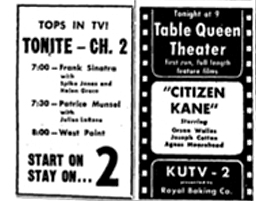 Sarris’s filmographies were packed with titles I’d never heard of. How could I catch up? Around 1955, the studios had begun selling their pre-1948 titles to local television stations. By the next year, people living in major cities could tune in five or six movies a day. At the forefront of TV sales was the financially precarious RKO, which sold over seven hundred titles to an outfit called C & C. C & C packaged the library as 16mm TV prints under the rubric of “Movietime.”
Sarris’s filmographies were packed with titles I’d never heard of. How could I catch up? Around 1955, the studios had begun selling their pre-1948 titles to local television stations. By the next year, people living in major cities could tune in five or six movies a day. At the forefront of TV sales was the financially precarious RKO, which sold over seven hundred titles to an outfit called C & C. C & C packaged the library as 16mm TV prints under the rubric of “Movietime.”
Auteurism owes a good deal to the 1950s-1960s equivalent of home video, the thousands of 16mm prints floating around local TV stations. In Manhattan, WOR-TV screened their films under the rubric “Million Dollar Movie.” The same film might run once or twice every night for a week (and twice or more on weekends). Without benefit of WOR or New York’s revival houses, I was still able to use Rochester television to sample some of the titles that Sarris had listed, especially those given in big caps. (Italicizing must-see items didn’t show up until the book version.) Sarris’s essay, “Citizen Kane: The American Baroque,” was published in Film Culture in 1956, the same year that the RKO library began to be syndicated and Kane was reissued in theatres around the country.
I did wind up subscribing to Film Culture. It was the least I could do to pay them back.
Obligatory autobiography 2
Fall 1965: At a state college up the Hudson, the English department hosted a debate on contemporary American movies. The adversaries were Pauline Kael and Andrew Sarris, both just coming into the national spotlight. One freshman came early and sat with comic earnestness in the front row, a spot he would fetishize later.
Kael was witty and acerbic, tossing off judgments with a wave of her cigarette holder. The Cincinnati Kid was the best of the current crop; Jewison showed great promise. She was riding high because I Lost It at the Movies had come out that spring and was greeted with hosannas. The New Yorker review contrasted her with “the far-out Sarris.”
He didn’t look so far-out. In a crumpled suit, he was resolutely uncharismatic, looking mildly unhappy to be dragged blinking out of the Thalia and shipped upstate. He talked fast, interrupted himself, and, finding few recent movies to praise, celebrated Max Ophuls and Jean Renoir. He delivered enigmatic observations like, “All movies should probably be in color.”
At evening’s end, I knew which camp I belonged in. I got an appropriately nerdy autograph for my Film Culture issue: “Cinecerely yours, Andrew Sarris.” More important, I exulted in a sense that my almost grim obsession with movies had been validated. Not for some time would I realize that I had enlisted, to put it melodramatically, in a fight for American film culture. The battle lines were drawn more sharply in Manhattan than in Albany, but everywhere one thing was clear. Kael was clearly the standard bearer for them, and Sarris was ours.
Obligatory comparison: S vs. K
Who were the them? They were the hip intellectuals who enjoyed a night at the movies. At faculty parties throughout the 1970s I had to check myself when professors of lit or law asked me if I didn’t find Kael’s review that week intoxicating. And she writes so well! As chief New Yorker critic, Kael became the grand tastemaker, a person even filmmakers courted. But who would try to curry favor with the guy who wrote for the Village Voice? It reminds you of the joke about the starlet so dumb she slept with the screenwriter.
Of course like all acolytes we overplayed the differences. Both Kael and Sarris loved classic studio cinema, the performers and scripts as much as the directorial handling. Both critics bemoaned Soviet montage and what they saw as its descendant, the overbusy technique of the 1960s. Both deplored stylistic aggressiveness (the Tony Richardson Syndrome) and both idolized Renoir. Both loved lyricism.
According to us, though, Kael wrote for those who dug movies, while Sarris wrote for those who loved cinema—the medium itself, or rather an exalted idea of the medium’s potential, an ideal form of expression at once dramatic, poetic, pictorial, and musical. He saw each film as bearing witness to the promise of what cinema might be, and he looked in even the tawdriest products for something approximating his dreams. Despite his enthusiasms, he tried for detachment, viewing the latest movie from some unpredictable historical perspective.
Kael famously declared that she watched a new film only once, because that was the way her readers would consume it. But who, we thought, would want to write about a movie after seeing it only once? Mightn’t it reveal some strengths or weaknesses on a second viewing? If it was a good movie, who wouldn’t want to see it more than once? In that same freshman semester, when there were still first-run double features, I sat through The Glory Guys twice in order to watch Help! three times. And that wasn’t even a particularly good movie.
Kael pounced on faults, Sarris savored beauties. Kael made each weak film seem like a blow to her intelligence. Sarris, although he could be harsh, tended to forgive. He taught that it was better to leave a door open than to write someone off—even Bergman, whom some of us would never learn to like until Persona, some not until Fanny and Alexander. Sarris subordinated his personality to that of the movie and its director, which made him seem less fiery than his uptown counterpart; but his attitude suited our own somewhat adolescent amorphousness of character. The arrogant certainty of our tastes was, paradoxically, born of a passionate humility, a sense of serving wise masters named Dreyer, Murnau, Mizoguchi.
Rethinking film history
Sarris is known primarily as the man who gave us the American version of auteurism, or what he called “the auteur theory.” It wasn’t a theory of cinema as such, but rather a heuristic approach to criticism: tips on what to think about and look for when you wanted to plumb a movie’s artistry. But initially, auteurism claimed to be a theory of something else. The opening chapter of The American Cinema is called “Toward a Theory of Film History.”
In Sarris’s day, most people writing about the history of film as an art accepted a notion of technical progress. According to this view, filmmakers became significant by contributing toward the development of the medium. Editing emerged through the efforts of Méliès, Porter, and Griffith, followed by the Russian Montage directors. Various national schools revealed more possibilities of the medium: fantasy and abstraction with the German Expressionists, derangement of sense with the Surrealists.
When sound arrived, a few directors (Clair, Mamoulian, Hitchcock) explored the stylized possibilities of that new technology. But many historians, considering that cinema was inherently a visual medium, declared sound an unwanted intrusion. Clearly, the great days of cinematic artistry were over. Most synoptic histories of the period fell silent about the evolution of technique after the 1920s and concentrate on the emergence of certain genres, such as the musical and the film of social comment.
Even André Bazin could be said to accept the premises of step-by-step artistic progress. Bazin showed that sound cinema wasn’t a dead end, that new artistic possibilities were exploited in the 1930s and 1940s. These were mostly creative alternatives to editing-based technique: the long take, extended camera movement, deep-space staging, and deep-focus cinematography. Bazin claimed that these techniques were most fully on display in the works of Renoir, Wyler, Welles, and some Neorealists.
Sarris was deeply influenced by Bazin’s ideas, but he didn’t accept the conception of film history as an accumulated technical evolution. Sarris called this the “pyramid fallacy,” with each filmmaker adding his slab to the rising and narrowing edifice of cinema. Instead, he proposed thinking of film history as an inverted pyramid, “opening outward to accommodate the unpredictable range and diversity of individual directors.”
In practice this demands that the historian survey entire careers, especially the works of ripe old age. It demands that the historian plot directors’ creative trajectories as paralleling and intersecting and overlapping—perhaps coalescing into broader trends, perhaps creating dead ends. The cinematic universe expands with each new film made, every old film rediscovered or simply re-seen. Auteurism “places a premium on having seen every work by a director who is deemed worthy of a study in depth; and by the time all the cross-references have been pursued in every possible direction auteurism seems to insist that every film ever made is relevant to the inquiry.”
Film history becomes less a linear progress toward something than a vast network of affinities and differences. This idea naturally led Sarris the writer not to the mammoth survey but to multifaceted essay collections. His big book, “You Ain’t Heard Nothin’ Yet,” looks like a panoramic history but is in fact a free-range miscellany, a sort of unbuttoned late-career redo of that Film Culture issue..
You can argue that Sarris was proposing a non-historical history, one that dispenses with concepts of influence and cause and that pulverizes any coherent narrative. That seems to me a valid objection. Despite its claim to be a theory of film history, Sarris’s auteurism strikes me as a historically informed approach to film criticism. The ultimate aim isn’t a convincing historical narrative but a compelling aesthetic judgment. Sarris’s idea of expanding filiation, infinite comparison and contrast, allows him to pursue what matters: evaluation.
In this respect at least, he’s agreeing with his predecessors, the writers who saw history as linear progress. But his criteria of value are different. For the traditionalists, the filmmakers who grasped the next step that the medium should take in its creative development become the best. For Sarris, the best filmmakers used the resources at their disposal to create valuable works that also displayed a distinct conception of human life. “Griffith, Murnau, and Eisenstein had different visions of the world, and their technical ‘contributions’ can never be divorced from their personalities.” Innovation was secondary to expression, and expression could best be gauged by tracking the wayward currents of the history of film style.
Auteur, yes; but of what?
New York Film Festival 1966: Pier Paolo Pasolini, translator, Andrew Sarris, and Agnes Varda. Photo by Elliott Landy. From Film Culture no. 42 (Fall 1966).
The auteur “theory” creates a decentralized and dispersed conception of film history—not a tree with a solid trunk and clear-cut branches but a bristling, tangled bush. The historian will dissolve big changes and broad trends into the doings of particular film artists. Who are these artists? Well, obviously, directors.
This move shouldn’t have been controversial. Critics had long assigned primary creative responsibility to directors. In the 1910s Louis Delluc heaped praise on DeMille and Sjöström, while Griffith was acknowledged around the world as a great innovator. Later von Stroheim, von Sternberg, Eisenstein, Pabst, Clair, Welles, Hitchcock, Maya Deren, and many other filmmakers were recognized as the artistic authority behind their work. In the early 1950s, foreign-language filmmakers such as Kurosawa and Bergman were identified (and even promoted by their distributors) as all-powerful creators saying something through their art.
Sarris’s real innovation was, along with the critics around Cahiers du cinéma and Movie, to transfer the idea of the expressive film artist from the headier regions of art cinema to the jostling, compromised world of Hollywood. There were obvious objections.
*Filmmaking is a “collaborative” activity, so you can’t attribute the final work to a single hand.
Yet in the collaborative medium of opera we speak of a Zeffirelli production as opposed to a Peter Sellars one. Why can’t a film director be a synthesizing artist orchestrating the contributions of many other artists?
*But in opera and other theatre forms, you have a preexisting text, the script or libretto or score. Why isn’t the screenwriter the artist, as Shakespeare or Verdi is?
Because theatrical texts are designed to be instantiated on different occasions, while film scripts are written to be produced only once. The film’s final form includes elements of the script, but that final form, being cinematic, can’t be uniquely specified in verbal language. As we all realize, give the same screenplay to six filmmakers, and you get six different and equally free-standing films.
*Popular film can’t be compared to high art. Artistry demands control, and the novelist, the painter, and even the opera director will exercise complete control over the final work. A Bergman or Antonioni has the cultural clout to dictate every aesthetic effect, but the Hollywood filmmaker works as part of a larger process controlled by others. He is handed a script and shoots it, and not necessarily all of it; second-unit and visual effects staff have their input too. The producer may demand more close-ups. In the classic studio system, the director wouldn’t typically get final cut; the producer would shape the released film. All these conditions constitute barriers to artistic expression. The auteur theory, when applied to Hollywood, is deeply inappropriate.
One answer to this objection is that many directors, including some of the best ones, did have a good deal of control over their work: Hitchcock, Hawks, and others were their own producers and worked on their scripts and oversaw their post-production. Moreover, a director can control choices down the line in sneaky ways, as when Ford shot his films so that they could be assembled in only one way.
Sarris advanced another reply to the control objection. If it owed something to the Cahiers young critics, he articulated and practiced it more keenly than they. He proposed a critical method: Take as many films signed by the director as you can find. Attend to the way they exercise their craft, the way they tell their stories and convey their meanings. Seek out an expressive core that seems distinctive, even unique.
Most directors’ collected works won’t yield this. “Not all directors are auteurs. Indeed, most directors are virtually anonymous.” Only the best directors will display a distinct expressive quality. Hawks and Hitchcock evoke radically different worlds of action and feeling, just as Mozart and Rembrandt can.
Fifteen years after his initial statement on the matter, “Notes on the Auteur Theory in 1962,” Sarris suggested that the elusive concept of personality was not to be derived from the director’s biography. “I was never all that interested in the clinical ‘personalities’ of directors. . . . A director’s formal utterances (his films) tell us more about his artistic personality than do his informal utterances (his conversation).”
For example, we understand John Ford’s respect for what Sarris calls “codes of conduct” not through the old curmudgeon’s interviews but by confronting the tangible texture of the movies. One of Sarris’s favorite examples occurs in The Searchers. Drinking his coffee, the Ward Bond character glances toward the wife of the household. Then his point of view reveals her stroking the uniform of her husband’s brother, played by John Wayne.
Cut back to Bond as the wife and her brother-in-law meet for a tender farewell. Bond stares off into space, chewing.
“Nothing on earth,” writes Sarris, “would ever force this man to reveal what he had seen. There is a deep, subtle chivalry at work here, and in most of Ford’s films, but it is never obtrusive enough to interfere with the flow of the narrative.” The economy is part of the point. “If it had taken him any longer than three shots and a few seconds to establish this insight into the Bond character, the point would not be worth making.”
In the Hollywood studio context, there was something heroic about the rare director who could surmount all the pressures, filter out all the noise, and shape the impact of his work. “The auteur theory values the personality of the director precisely because of the barriers to its expression.” Like a great Renaissance painter paid by a pope or a duke and pledged to illustrate well-known stories, the Hollywood director working for a studio could occasionally conjure up something powerful and distinctive.
Auteurism, Sarris claimed, is our straightest road to determining a film’s value. The great films, by and large, will be those that evoke distinctive directorial sensibilities. But “by and large” allows for the possibility of excellent movies that we can attribute to other forces—script, stars, source material, the happy intersection of talents. Casablanca, writes Sarris, “is the most decisive exception to the auteur theory.” Sarris loved movies more than he loved his theories.
Compare, contrast, repeat
Sarris’s breakthrough essay, “Citizen Kane: The American Baroque,” appeared in Film Culture during the 1956 revivals of the film. This detailed explication, published when Sarris was twenty-eight, betrays his grad-school training at a period when the New Criticism reigned. In a single stroke, he pioneered the sort of close reading that would become central to Anglo-American academic film criticism.
I can’t recall any later Sarris essay offering such an intensive analysis of a single film. As he developed his historically-guided critical appraisals, he favored synoptic appreciations of directorial careers. These became the occasions for him to point out interacting directorial personalities that comprise that vast network of cinema.
Instead of macro-analysis, Sarris embraced a strategy of “drilling down,” we’d now say, to a single revelatory passage. The chief tactic is comparison, often involving two directors faced with a comparable situation. Both City Lights and The Goat show a protagonist hiding on a statue about to be unveiled. Chaplin seizes the chance to deflate the ceremony.
But Keaton, says Sarris, is less interested in satire; he is “a pessimist in perpetual motion.” In The Goat, “Keaton remains mounted on the clay horse until it begins to sag and crumple under his weight, and the sculptor, a bearded nincompoop in a beret, proceeds to break down and weep.”
“Keaton’s expression here,” Sarris claims, “is mercilessly pragmatic. What good is a clay horse (art?) if you can’t mount it to your own advantage? There is something unabashedly ruthless about Keaton’s comedy, which chills his humor.” This was the period when critics, having just rediscovered Keaton’s films, claimed him as a “metaphysician.” Sarris likened him to Beckett.
Sarris wasn’t alone in turning to detailed commentary at the period; we had Dwight Macdonald’s appreciative 1964 essay on 8 ½ and John Simon’s book-length study of Bergman (1973). But Sarris got there early with the Kane piece, and throughout his career he used analysis to pinpoint authorial personality. Attention to nuanced differences allowed him to create a kind of connoisseurship.
The ultimate expression of this connoisseurship emerges in his concern for privileged moments. A critic has to be alert for shots or gestures or lines of dialogue that encapsulate the emotional tenor of a film and a director’s sensibility. Sarris’ example is a moment in La règle du jeu:
Renoir gallops up the stairs, stops in hoplike uncertainty when his name is called by a coquettish maid, and then, with marvelous post-reflex continuity, resumes his bearishly shambling journey to the heroine’s boudoir.
If I could describe the musical grace note of that momentary suspension, and I can’t, I might be able to provide a more precise definition of the auteur theory. As it is, all I can do is point at the specific beauties of interior meaning on the screen and later catalogue the moments of recognition.
No director but Renoir, Sarris suggests, would have Octave break the scene’s rhythm in exactly this way–and in a manner, Sarris’s bear-metaphor hints, that anticipates Octave’s costume for the climactic party in the chateau. The nonchalant, slightly awkward interruption epitomizes Renoir’s entire style of filmmaking, which has room for casual deflections from neat plotting and groomed performances. The critic’s words can’t wholly capture the force of Octave’s hop, and its resonance for Renoir’s film and his oeuvre. It is, says Sarris, “imbedded in the stuff of cinema.”
Both cinephiles and ordinary viewers are seized by luminous instants that change our skin temperature. We come out of a film satisfied if a few epiphanies have flashed upon us. The critic can signal them but not explain them fully. Interior meaning is the product of craft and personality, but it can’t be reduced to them. It creates a tingling, fugitive beauty that is unique to cinema.
Everyone has his or her own Sarris. The foregoing offers merely bits of mine, and they’re largely academic in slant. That’s because I think that Sarris changed, among other things, the way film history and criticism were taught in American universities. While Kael influenced film journalism, particularly in the upscale markets, Sarris’s legacy is best seen in cinephile criticism (Film Comment, Film Quarterly et al.) and academic film studies. Some Paulettes went to work for the New York cultural weeklies, high and low. Many people who were Sarrisites to some degree (Jeanine Basinger, James Naremore, John Belton, William Paul, Elisabeth Weis, Chuck Wolfe, Mark Langer, Robert Lang, et al.) became professors. Kael’s followers turned out essays, but Sarrisites like Todd McCarthy and Joseph McBride wrote books based firmly in research. Sarris’s version of auteurism has been reworked, in plenty of intriguing ways, in directorial monographs from university presses. He once remarked ruefully that he was an academic among journalists and a journalist among academics, but he managed to bridge the gap adroitly.
Sarris was too far-out for the New Yorker in 1965, and probably for the New Yorker of today. But history, and not just the history of movies, was on his side.
Sarris’ life and death have called forth many eloquent tributes. Among the best are Kent Jones’ career overview, Richard Corliss’s moving memoir, and Jim Emerson’s calm discussion of the excesses of the Sarris vs. Kael dichotomy. See also Ben Kenigsberg’s memories of Sarris’s teaching style.
My quotations are taken from Film Culture no. 28 (Spring 1963), The American Cinema (Dutton, 1968), Confessions of a Cultist: On the Cinema, 1955/1969 (Simon and Schuster, 1971), The Primal Screen (Simon & Schuster, 1973), and The John Ford Movie Mystery (Secker & Warburg, 1976). Thanks also to email conversations with John Belton of Rutgers and Dennis Bingham of Indiana University.
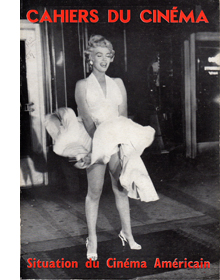 When I received Film Culture no. 28, I didn’t know that it represented a continuation of a Cahiers du cinéma tradition. In December 1955, the journal had published a special issue, “Situation du Cinéma Américain” (no. 54). It included not only critical essays but a “dictionary” of contemporary American directors: small-print filmographies followed by a paragraph of lapidary commentary. (“Lang’s work is founded on a metaphysics of architecture.”) Later issues devoted “dictionaries” to current French cinema (no. 71, May 1957), the Nouvelle Vague (no. 138, December 1962), and more recent American cinema (no. 150-151, December 1963-January 1964). In his American Cinema project, Sarris altered the format significantly by expanding the commentaries into essays and then grouping directors within sharp-edged, highly memorable categories of value. In turn, Sarris’s catalogue seems to have been the model for Martin Scorsese’s “Personal Journey through American Movies.” In the same tradition is Jean-Pierre Coursodon and Pierre Sauvage’s too-little-known American Directors (1983).
When I received Film Culture no. 28, I didn’t know that it represented a continuation of a Cahiers du cinéma tradition. In December 1955, the journal had published a special issue, “Situation du Cinéma Américain” (no. 54). It included not only critical essays but a “dictionary” of contemporary American directors: small-print filmographies followed by a paragraph of lapidary commentary. (“Lang’s work is founded on a metaphysics of architecture.”) Later issues devoted “dictionaries” to current French cinema (no. 71, May 1957), the Nouvelle Vague (no. 138, December 1962), and more recent American cinema (no. 150-151, December 1963-January 1964). In his American Cinema project, Sarris altered the format significantly by expanding the commentaries into essays and then grouping directors within sharp-edged, highly memorable categories of value. In turn, Sarris’s catalogue seems to have been the model for Martin Scorsese’s “Personal Journey through American Movies.” In the same tradition is Jean-Pierre Coursodon and Pierre Sauvage’s too-little-known American Directors (1983).
For more on C & C, which was a soda-pop company, go here. By 1956, WOR-TV was owned by the same company that owned RKO, so it’s no surprise that Kane, King Kong, and other items from the Movietime package played ceaselessly on that station. WOR’s radio station intersected my life from another angle.
For more on the standard version of the history of film art, along with Bazin’s revision of it, see my On the History of Film Style.
The homage volume, Citizen Sarris: American Film Critic, includes many fine pieces, but please don’t read my contribution. Editorial carelessness has mangled it beyond recognition. The version I’ll stand by, “Cinecerity,” is available in my Poetics of Cinema. Portions of this blog entry are lifted from that essay, but I’ve omitted most of my discussion of Sarris’s conception of film style.
New York Film Festival, 1966: Nat Hentoff, Pauline Kael, Parker Tyler, Arthur Knight, Judith Crist, Hollis Alpert, Andrew Sarris. Photo by Elliott Landy. From Film Culture no. 42 (Fall 1966).
PS 24 June 2012: More moving commentary in memoriam at the Film Comment site.












